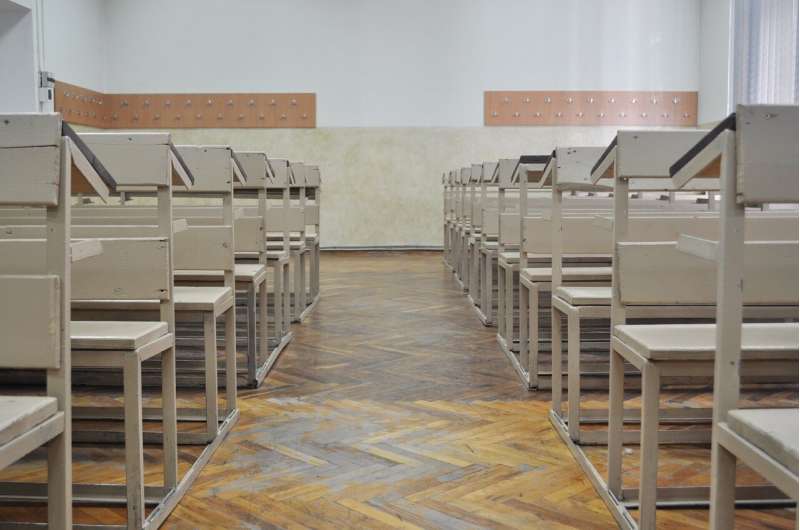This article has been reviewed according to Science X's editorial process and policies. Editors have highlighted the following attributes while ensuring the content's credibility:
fact-checked
trusted source
proofread
Mass shooting lockdown drills help schoolchildren feel safer, US study suggests

Lockdown drills, practiced to help prepare children for shooting incidents at school, make those who have been exposed to violence feel safer, a new study of thousands of students in the US indicates.
The finding, reported in a paper published in the Journal of School Violence, contradicts claims that the drills traumatize children, without making them feel safer.
Ensuring that students feel safe—and are safe—in schools is essential for them to learn and thrive, explains researcher Dr. Jaclyn Schildkraut, Executive Director of the Regional Gun Violence Research Consortium at the Rockefeller Institute of Government in the US.
One safety measure that's widely practiced in the US is lockdown drills. The drills, which are carried out at almost all public schools, involve locking classroom doors, turning off the lights, staying out of sight, and remaining quiet.
They were introduced after the Columbine High School massacre of 1999, in which two teenagers shot dead 12 of their fellow pupils and a teacher and wounded 24 others.
Lead author, Dr. Schildkraut joined colleagues from the University at Buffalo, University at Albany, and Syracuse University to explore how lockdown drills affect perception of school safety in children who have been exposed to violence.
While mass shootings are rare, a nationwide survey found that almost half of school-aged children in the US had been exposed to bullying or violence in the previous year, while at school.
"It is important for students to perceive their schools to be safe because it can impact how they function as students generally," says Dr. Schildkraut, a national expert on mass shootings research. "For instance, not feeling safe at school can lead to anxiety, depression, lowered academic performance and missing school.
"In addition, not feeling safe at school can lead students to have increased perceptions of risk—thinking they are more likely to be harmed at school than they actually are—or be adversely impacted by practices designed to keep them safe, like lockdown drills."
For the study, students in fifth grade and above in a large urban school district in New York State were asked to fill in a survey about how safe they felt at school and how prepared they were for lockdowns and other emergencies.
The students were also surveyed on their exposure to violence. They were asked if they had seen or heard of someone bring a gun to school; seen someone bring a knife to school; been involved in or seen one or more physical fights; or been bullied or seen someone else being bullied.
The students then participated in a lockdown drill before filling out the survey again.
Several months later, they were given training on how to respond to emergencies. They then took part in a second lockdown drill and filled in the survey for a third time.
Some 8,627 surveys were completed by students with an average age of 14. The males and younger children tended to feel safer than females and other children. The respondents had been exposed to 1.9 types of violence, on average. The most common forms were witnessing fights and witnessing bullying.
Those who had been exposed to violence felt less safe at school than others and the more types of violence they'd been exposed to, the less safe they felt. However, taking part in the drills and training seemed to, at least in part, mitigate the harmful effects of the exposure to violence.
Dr. Schildkraut says, "Participating in drills may be a way to help students who have been exposed to violence feel safer in schools. This finding provides policymakers with direct empirical evidence against calls for lockdown and other safety drills to be abandoned on the basis that they traumatize children without making them feel safer."
Students who had been exposed to violence felt less prepared for emergencies than others but the respondents as a whole felt more prepared for emergencies after taking part second drill than at the start of the study.
Dr. Schildkraut adds, "The main purpose of emergency preparedness drills, including lockdowns, is for individuals to build muscle memory, which enables them to respond correctly in stressful situations without conscious effort. And so, it is possible that the confidence gained from taking part lockdown drills may help to offset the negative effects of exposure to violence over time."
She notes that more research is needed to determine whether their findings apply to children in more rural areas, where levels of violence may be lower. Similarly, further work is needed to confirm that the results apply to lockdown drills other than the one used in the study.
Other limitations include the inability to prove causation and to track individual students' responses over time.
The authors conclude, "When lockdown drills are conducted correctly they can offer unintended benefits, such as offsetting harmful effects of exposure to violence, in addition to helping to prepare students for emergencies."
They also urge policymakers to do more to tackle violence in schools.
"All students deserve a safe, supportive and healthy learning environment in which they can thrive as students and as individuals," says Dr. Schildkraut.
More information: Assessing the Relationship between Exposure to Violence and Perceptions of School Safety and Emergency Preparedness in the Context of Lockdown Drills, Journal of School Violence (2024). DOI: 10.1080/15388220.2023.2291655. tandfonline.com/doi/full/10.10 … 5388220.2023.2291655
Provided by Taylor & Francis




















